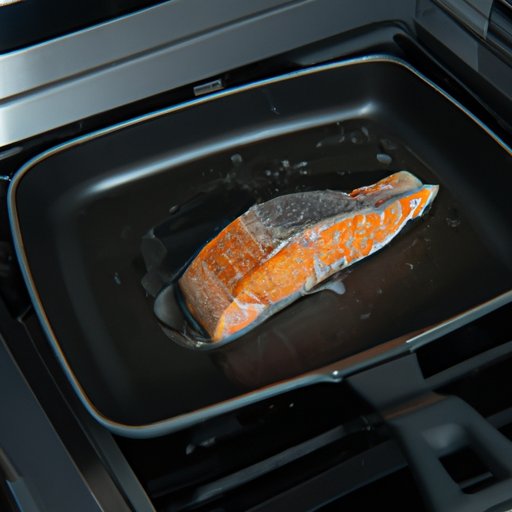
Introduction
Salmon is a delicious and healthy seafood option, but cooking it to perfection can be a challenge. Overcooking it can lead to dry, rubbery fish, while undercooking it can be unsafe to eat. In this article, we will explore different methods and techniques for cooking salmon perfectly every time.
A Beginner’s Guide: Cooking Salmon to Perfection
Cooking salmon begins with choosing the right thickness and type of cooking method. For a fillet less than one inch in thickness, you need to cook it quickly over high heat. However, thicker fillets require more time and gentler cooking such as oven-baking or sous vide cooking.
The following table shows the recommended cook times for salmon fillets based on different factors:
| Thickness | Cooking Method | Cook Time |
|---|---|---|
| 1/2 inch | Pan-searing | 2-3 minutes per side |
| 1 inch | Grilling | 4-6 minutes per side |
| 1 1/2 inch | Oven-baking | 12-15 minutes at 400°F |
| 2 inch | Sous vide cooking | 45-60 minutes at 125°F |
To cook salmon perfectly every time, use a meat thermometer to check the internal temperature. The ideal temperature should be around 145°F.
Grilling Salmon: Tips and Techniques
Grilling is a perfect way to cook salmon, as it adds a smoky flavor and beautiful grill marks to the fish. Place the salmon, skin-side-down, onto the grill grates and close the lid. Turn over the fillet using a spatula when the skin begins to release from the grates. For a 1-inch thick fillet, grill for 4-6 minutes per side.
For delicious char, brush the salmon with oil and sprinkle with salt and pepper before grilling. Additionally, try glazing your salmon with a teriyaki or honey-dijon glaze to add more flavor.
Oven-Baked Salmon: A Juicy and Flavorful Way to Cook Fish
Oven-baking salmon is an excellent technique to achieve a juicy and flavorful fish. Preheat the oven to 400°F and line a baking sheet with parchment paper. Place the salmon, skin-side-down, on the baking sheet, and bake for 12-15 minutes.
For a crispy crust, add panko breadcrumbs, chopped herbs, or almonds to the top of the salmon before baking. Also, season the salmon with your favorite spices or herbs to complement the flavors.
Pan-Seared Salmon for the Busy Weeknight
Pan-seared salmon is fantastic for a quick and delicious weeknight meal. Heat some oil in a non-stick skillet over medium-high heat until hot. Place the salmon, skin-side-up, on the pan and cook for 2-3 minutes per side for a 1/2 inch thick fillet.
For extra flavor, add garlic, herbs, or lemon juice to the pan. Also, try serving your salmon with your favorite side dishes, such as roasted vegetables or rice pilaf.
Delicious Salmon Dishes to Add to Your Menu
There are countless ways to prepare salmon, grilled, oven-baked, or pan-seared; here are some recipe options:
- Grilled Salmon with Lemon and Herbs: Brush salmon with lemon juice, herbs, and garlic before grilling.
- Oven-Baked Salmon with Pesto Crust: Top salmon with pesto, panko breadcrumbs and bake in the oven.
- Pan-Seared Salmon with Garlic and Lemon: Sauté garlic and lemon juice in olive oil and sear salmon fillets in the same pan.
Sous Vide Salmon: A Foolproof Way to Cook Fish
Sous vide cooking is a foolproof and low-maintenance way to cook salmon. Heat water to 125°F, season the salmon fillets with salt, pepper, and herbs, and place it in a sous vide bag. Seal the bag and cook for 45-60 minutes.
Finish your salmon by searing it briefly in a hot skillet or on the grill for extra flavor and texture.
Experimenting with Cooking Times for Salmon
Different factors, including altitude, fish cut, and thickness, can affect the cooking time for salmon; therefore, it is best to experiment and adjust the times according to these factors. Be sure to use a meat thermometer to check the internal temperature of the fillet, and test the doneness by pressing the center of the fish with a fork. The fish should flake easily but still be moist to achieve a juicy texture.
Conclusion
Cooking salmon can be intimidating, but with these techniques and tips, you can cook delicious and perfectly cooked salmon every time. Experiment with different cooking methods, and don’t be afraid to try new recipes.




